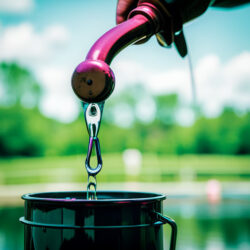Paraquat Lawsuit [2024]: Were You or a Loved One Diagnosed With Parkinson's Disease After Using Para
The recent surge in legal battles surrounding Paraquat, a herbicide linked to Parkinson's disease, underscores the critical need for individuals and their families to stay informed on the evolving landscape of litigation. As the cases against giants like Syngenta Crop Protection, LLC, and Chevron USA, Inc. proceed, with over 5,000 consolidated in a significant Multidistrict Litigation, the implications for those exposed to Paraquat cannot be overstated. With the postponement of bellwether trials and ongoing Daubert hearings, the question remains: how will these developments affect potential plaintiffs, and what steps should they consider next? This juncture presents an opportunity to explore the intersection of legal recourse and public health concerns further.
![Paraquat Lawsuit [2024]: Were You Or A Loved One Diagnosed With Parkinson'S Disease After Using Para 31 paraquat lawsuit for parkinson s](https://lawsuitlegit.com/wp-content/uploads/2024/02/paraquat_lawsuit_for_parkinson_s.jpg)
Understanding Paraquat
Paraquat, a widely utilized non-selective herbicide, plays a significant role in agriculture by controlling weeds and grasses on crops such as fruits, vegetables, nuts, and grains. Its effectiveness and efficiency in weed management have made it a tool of choice for farmers seeking to improve crop yields and reduce labor costs. Paraquat is recognized by its distinctive blue tint and pungent odor, distinguishing it from other agricultural chemicals. It is available under various brand names, including Cyclone SL 2.0 and Para-Shot 3.0. Its application spans across various agricultural practices, from large-scale farming operations to more localized horticultural endeavors. The use of paraquat in crop management highlights its importance in maintaining agricultural productivity and sustaining the global food supply chain.
Parkinson's Disease Link
![Paraquat Lawsuit [2024]: Were You Or A Loved One Diagnosed With Parkinson'S Disease After Using Para 32 neurological disorder research advances](https://lawsuitlegit.com/wp-content/uploads/2024/02/neurological_disorder_research_advances.jpg)
Recent research has established a concerning connection between exposure to the herbicide commonly known as paraquat and an increased risk of developing Parkinson's disease. This neurological disorder, characterized by tremors, stiffness, and difficulty with balance and coordination, has been increasingly linked to environmental factors, including the use of certain pesticides. Paraquat, recognized for its effectiveness in controlling weeds and grasses, has come under scrutiny for its potential neurotoxic effects. Studies suggest that individuals exposed to paraquat, whether through occupational use or accidental contact, may have a significantly higher likelihood of developing Parkinson's disease compared to those with no exposure. The mechanism behind this association is thought to involve paraquat's ability to induce oxidative stress and neuronal damage, highlighting the critical need for further investigation and preventive measures.
Lawsuit Overview
![Paraquat Lawsuit [2024]: Were You Or A Loved One Diagnosed With Parkinson'S Disease After Using Para 33 legal action summary provided](https://lawsuitlegit.com/wp-content/uploads/2024/02/legal_action_summary_provided.jpg)
The wave of litigation surrounding the alleged link between paraquat exposure and Parkinson's disease marks a significant chapter in environmental health law. As investigations into the connection have deepened, thousands of individuals allege that exposure to paraquat, a widely used herbicide, has led to the development of Parkinson's disease. The legal proceedings have been consolidated into a multidistrict litigation (MDL) in the U.S. District Court for the Southern District of Illinois, reflecting the complexity and scale of these cases. The process involves rigorous examination of scientific evidence, expert testimonies, and the impact of paraquat exposure on human health. Plaintiffs seek justice and compensation for the harm they attribute to paraquat, setting a precedent in the realm of product liability and environmental justice.
Defendants Identified
--v 6 --ar 16:9
![Paraquat Lawsuit [2024]: Were You Or A Loved One Diagnosed With Parkinson'S Disease After Using Para 34 defendants identities were revealed](https://lawsuitlegit.com/wp-content/uploads/2024/02/defendants_identities_were_revealed.jpg)
In the ongoing litigation concerning Parkinson's disease allegedly linked to paraquat exposure, Syngenta Crop Protection, LLC, and Chevron USA, Inc. have been named as the primary defendants. These companies are at the center of numerous lawsuits alleging that exposure to paraquat, a herbicide they produced or distributed, has led to individuals developing Parkinson's disease. The legal actions argue that the defendants failed to warn users about the severe risks associated with paraquat, including its potential to cause neurodegenerative disorders. As the cases proceed, the focus on these two corporations underscores the critical questions of product safety, corporate responsibility, and the duty to protect consumers from harmful exposures. The outcomes of these cases could have significant implications for both the plaintiffs and the defendant companies involved.
Exposure Pathways
![Paraquat Lawsuit [2024]: Were You Or A Loved One Diagnosed With Parkinson'S Disease After Using Para 35 understanding lead exposure risks](https://lawsuitlegit.com/wp-content/uploads/2024/02/understanding_lead_exposure_risks.jpg)
Understanding the various ways individuals may come into contact with paraquat is crucial for comprehending the risks associated with its use. Exposure to paraquat can occur through several pathways, primarily including inhalation, skin contact, or ingestion. Those working in agricultural settings, where paraquat is commonly applied to crops such as fruits, vegetables, nuts, and grains, are at higher risk. Inhalation can happen during the mixing, loading, or application of paraquat-containing herbicides. Skin contact may occur if protective clothing is not adequately used, while accidental ingestion can happen if paraquat is transferred to food or drink containers improperly. Each exposure pathway poses significant health risks, emphasizing the importance of strict adherence to safety protocols when handling paraquat.
Case Consolidation
![Paraquat Lawsuit [2024]: Were You Or A Loved One Diagnosed With Parkinson'S Disease After Using Para 36 case consolidation benefits all](https://lawsuitlegit.com/wp-content/uploads/2024/02/case_consolidation_benefits_all.jpg)
Case consolidation in the U.S. District Court for the Southern District of Illinois represents a critical juncture for over 5,000 Paraquat lawsuits, streamlining the legal process and potentially influencing outcomes. This strategic move allows for a more efficient handling of pre-trial proceedings, including discovery and motions. By merging these cases, the court aims to reduce redundancy, minimize legal expenses, and accelerate the path to trial or settlement. This consolidation is particularly significant given the complexity and volume of the litigation, centered around allegations that exposure to Paraquat, a widely used herbicide, is linked to the development of Parkinson's Disease. The unified approach underscores the gravity of the claims and the urgency for a resolution that addresses the plaintiffs' grievances.
Legal Developments
![Paraquat Lawsuit [2024]: Were You Or A Loved One Diagnosed With Parkinson'S Disease After Using Para 37 legal changes and updates](https://lawsuitlegit.com/wp-content/uploads/2024/02/legal_changes_and_updates.jpg)
Recent legal developments in the Paraquat litigation landscape have highlighted the ongoing complexities and challenges facing both plaintiffs and defendants. The consolidation of cases into a Multi-District Litigation (MDL) in the U.S. District Court for the Southern District of Illinois marks a significant step towards managing the over 5,000 pending lawsuits efficiently. These cases allege that exposure to Paraquat, a widely used herbicide, has led to Parkinson's disease. Recent Daubert hearings have put the spotlight on the battle over the admissibility of expert testimony, a critical element for both sides. Plaintiffs have challenged the validity of defendants' expert witnesses, aiming to undermine their arguments and bolster their own cases. This legal wrangling underscores the contentious nature of the litigation, with significant implications for all involved.
Bellwether Trials
![Paraquat Lawsuit [2024]: Were You Or A Loved One Diagnosed With Parkinson'S Disease After Using Para 38 bellwether litigation in progress](https://lawsuitlegit.com/wp-content/uploads/2024/02/bellwether_litigation_in_progress.jpg)
Bellwether trials, initially scheduled for August 2023, have been postponed, marking a pivotal moment in the ongoing Paraquat litigation. This delay reflects the complexity and significance of these cases, which are designed to test legal theories and potential outcomes for thousands of similar lawsuits consolidated in the Multi-District Litigation (MDL) process. The postponement allows both parties to further prepare their cases, underscoring the litigation's intricate nature. Bellwether trials are a critical component of the MDL process, providing a framework for possible settlement negotiations and setting precedents for remaining cases. As the legal battle unfolds, all eyes remain on how these initial trials will shape the landscape of Paraquat litigation, influencing future proceedings and potential resolutions for thousands of plaintiffs alleging harm from Paraquat exposure.
Expert Testimonies
![Paraquat Lawsuit [2024]: Were You Or A Loved One Diagnosed With Parkinson'S Disease After Using Para 39 expert opinions and testimonies](https://lawsuitlegit.com/wp-content/uploads/2024/02/expert_opinions_and_testimonies.jpg)
Following the postponement of bellwether trials, a critical focus has shifted to the expert testimonies presented by both plaintiffs and defendants in the Paraquat litigation. The crux of these testimonies revolves around the alleged link between Paraquat exposure and the development of Parkinson's disease. Plaintiffs' experts have been meticulously detailing the biochemical pathways and epidemiological evidence supporting this connection, emphasizing the herbicide's neurotoxic effects. Conversely, defendants' experts challenge these assertions, questioning the methodologies and conclusions of studies cited by plaintiffs. They argue against a definitive causation, highlighting alternative factors that could contribute to Parkinson's. This clash of expert opinions is pivotal, as it directly influences the jury's understanding of complex scientific arguments central to the case's outcome.
Filing Deadlines
![Paraquat Lawsuit [2024]: Were You Or A Loved One Diagnosed With Parkinson'S Disease After Using Para 40 meeting tax return deadlines](https://lawsuitlegit.com/wp-content/uploads/2024/02/meeting_tax_return_deadlines.jpg)
Understanding the statutes of limitation and repose is essential for potential plaintiffs considering legal action against Paraquat manufacturers, as these laws dictate the time frame within which a lawsuit must be filed. These deadlines can vary significantly by jurisdiction, often ranging from one to several years from the date of diagnosis or exposure. In the context of Paraquat litigation, missing these deadlines may entirely bar individuals from pursuing compensation for their injuries. Given the complexity and variations in laws across states, it's crucial to be aware of the specific limitations period applicable to your case. Acting swiftly to file a claim is paramount to preserving your legal rights and ensuring your case is heard.
Seeking Legal Advice
![Paraquat Lawsuit [2024]: Were You Or A Loved One Diagnosed With Parkinson'S Disease After Using Para 41 legal counsel is essential](https://lawsuitlegit.com/wp-content/uploads/2024/02/legal_counsel_is_essential.jpg)
Seeking legal counsel is a critical step for individuals exposed to Paraquat and diagnosed with Parkinson's disease, ensuring informed decisions regarding potential lawsuits. Experienced attorneys can provide essential guidance on navigating the complex legal landscape surrounding Paraquat litigation. They evaluate the specifics of each case, determining the viability of a lawsuit based on exposure history and medical diagnoses. Legal professionals are adept at interpreting the nuances of statutes of limitations, which vary by jurisdiction and can significantly impact the ability to seek compensation. Engaging with a legal expert also offers insight into the litigation process, expected timelines, and potential outcomes. Ultimately, securing legal representation maximizes the chances of achieving a favorable resolution, advocating for the rights and interests of those affected by Paraquat exposure.
Product Identification
![Paraquat Lawsuit [2024]: Were You Or A Loved One Diagnosed With Parkinson'S Disease After Using Para 42 product identification and labeling](https://lawsuitlegit.com/wp-content/uploads/2024/02/product_identification_and_labeling.jpg)
Amid the complexities of pursuing legal action for Paraquat exposure, accurately identifying the product linked to health issues is a foundational step. Plaintiffs must pinpoint the specific Paraquat-containing herbicides, such as Cyclone SL 2.0 or Para-Shot 3.0, involved in their exposure. These products are distinguishable by their blue tint and distinctive odor, markers that can aid in identification. Recognizing the exact product is crucial for establishing a direct link between the herbicide and the development of Parkinson's disease. This process involves gathering and presenting evidence of use, which may include purchase records, testimonies, or photographs, to substantiate claims. Proper product identification strengthens the case, aligning it with legal requirements and increasing the likelihood of a favorable outcome.
Health Consultations
![Paraquat Lawsuit [2024]: Were You Or A Loved One Diagnosed With Parkinson'S Disease After Using Para 43 virtual health consultations online](https://lawsuitlegit.com/wp-content/uploads/2024/02/virtual_health_consultations_online.jpg)
Following exposure to Paraquat and a subsequent diagnosis of Parkinson's disease, consulting with healthcare professionals is a critical step for affected individuals. These consultations are essential for obtaining an accurate assessment of one's health status and for discussing potential treatment options. Healthcare providers, including neurologists who specialize in movement disorders, can offer insights into managing symptoms and improving quality of life. Additionally, healthcare professionals can provide documentation that links Paraquat exposure to Parkinson's disease, which may be necessary for legal purposes. It's important for patients to share their exposure history and any symptoms with their healthcare team to ensure a comprehensive evaluation. Prompt medical consultation can also help in identifying and employing the most effective treatment strategies early in the disease's progression.
Other Legal Cases
![Paraquat Lawsuit [2024]: Were You Or A Loved One Diagnosed With Parkinson'S Disease After Using Para 44 legal proceedings in court](https://lawsuitlegit.com/wp-content/uploads/2024/02/legal_proceedings_in_court.jpg)
In addition to the Paraquat litigation, there are numerous other legal cases currently underway that address a wide range of health and safety concerns, including asbestos exposure, product liability, and corporate negligence. These include lawsuits for mesothelioma claims stemming from asbestos exposure, actions against hair relaxer manufacturers for uterine cancer, and cerebral palsy cases tied to medical malpractice. The legal landscape is also witnessing litigation against rideshare companies for incidents of sexual assault, as well as claims related to social media addiction and the adverse effects of products like kratom. Furthermore, cases of toxic exposure at places like Camp Lejeune and issues with infant formulas are prompting serious legal scrutiny, highlighting the multifaceted nature of public health-related legal challenges.
Lawsuit Eligibility
![Paraquat Lawsuit [2024]: Were You Or A Loved One Diagnosed With Parkinson'S Disease After Using Para 45 legal claim eligibility criteria](https://lawsuitlegit.com/wp-content/uploads/2024/02/legal_claim_eligibility_criteria.jpg)
Understanding the scope of legal cases such as those related to Paraquat exposure necessitates a detailed examination of lawsuit eligibility criteria. Eligibility primarily hinges on a diagnosis of Parkinson's disease following exposure to Paraquat through inhalation, skin contact, or ingestion. Potential plaintiffs must have a documented history of exposure in settings where Paraquat was used, such as farms or agricultural sites. Timing is crucial; statutes of limitation apply, setting strict deadlines for filing claims. It is imperative for affected individuals to seek legal consultation promptly to assess their case's viability. Each claim undergoes rigorous review, considering the specifics of exposure, medical diagnosis, and the impact on the plaintiff's life, ensuring that only those genuinely affected pursue litigation.
Frequently Asked Questions
How Does the Compensation Process Work for Individuals Diagnosed With Parkinson's Disease Due to Paraquat Exposure, and What Factors Determine the Amount of Compensation?
The compensation process for individuals diagnosed with Parkinson's disease attributed to toxic exposure involves legal action against responsible entities. Factors determining compensation amounts include severity of the diagnosis, impact on quality of life, medical expenses, lost wages, and future care needs. Plaintiffs must provide evidence linking their condition directly to the exposure. Legal proceedings typically involve multidistrict litigation, with settlements negotiated based on individual case merits and collective lawsuit outcomes.
Are There Specific Geographical Regions or Occupational Sectors That Have Seen a Higher Incidence of Parkinson's Disease Claims Related to Paraquat Exposure?
Investigations into Parkinson's disease claims have identified certain geographical regions and occupational sectors with elevated incidences related to herbicide exposure. Agricultural communities, particularly those involved in extensive crop farming, have reported higher cases. This trend is noticeable in areas with significant use of herbicides for crop protection. Workers in these sectors, including farming and groundskeeping, are at a heightened risk due to their direct and prolonged exposure to these chemicals.
How Does Co-Exposure to Other Agricultural Chemicals Influence the Outcome of a Paraquat Lawsuit, and Are There Considerations for Combined Chemical Exposures in the Legal Process?
In litigation concerning exposure to agricultural chemicals, co-exposure to multiple substances can significantly influence case outcomes. Legal considerations for combined chemical exposures require meticulous examination of each substance's contribution to alleged health conditions. This complexity necessitates robust scientific evidence to establish causation, particularly in scenarios involving substances like paraquat. Courts may assess combined exposures to determine liability and apportion damages, underscoring the importance of comprehensive evidence in such cases.
What Are the Long-Term Health Monitoring and Support Options Available for Plaintiffs Who Have Settled or Won Their Paraquat Exposure Cases?
For individuals who have successfully settled or won exposure cases, long-term health monitoring and support can include comprehensive medical evaluations, ongoing treatment for related conditions, access to specialized healthcare professionals, and possibly participation in support groups or counseling services. It's crucial to consult with legal and medical professionals to understand the specific benefits and support options available, which can vary based on the terms of the settlement or court decision.
How Do Paraquat Lawsuit Proceedings Impact Ongoing and Future Use Regulations for Paraquat in the U.S., and Are There Legislative Actions Being Considered as a Result of These Cases?
The proceedings of paraquat lawsuits have significant implications for the regulatory landscape of paraquat usage in the United States. These cases spotlight the potential health risks associated with paraquat, prompting regulatory bodies and legislators to reevaluate safety standards and usage permissions. Legislative actions, including stricter regulations or bans, may be considered as a direct result of the findings and public pressure stemming from these lawsuits, aiming to protect public health and safety.
![Paraquat Lawsuit [2024]: Were You Or A Loved One Diagnosed With Parkinson'S Disease After Using Para 46 Attorneys for Austin Talcum Powder Ovarian Cancer Lawsuits](https://lawsuitlegit.com/wp-content/uploads/2023/08/ai_author-as-a_female_attorney_that_looks_like_it_75541e66-67db-4828-a4ef-40ed56204132.jpg)
This post has been generated by AI and was not reviewed by editors. This is Not legal advice. Please consult with an attorney.

![Firefighting Foam Lawsuit [2024]: Were You Or A Loved One Diagnosed With Cancer 48 foam lawsuit cancer diagnosis](https://lawsuitlegit.com/wp-content/uploads/2024/02/foam_lawsuit_cancer_diagnosis-150x150.jpg)


